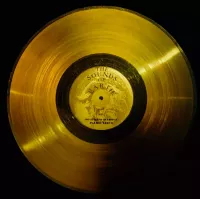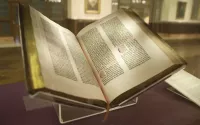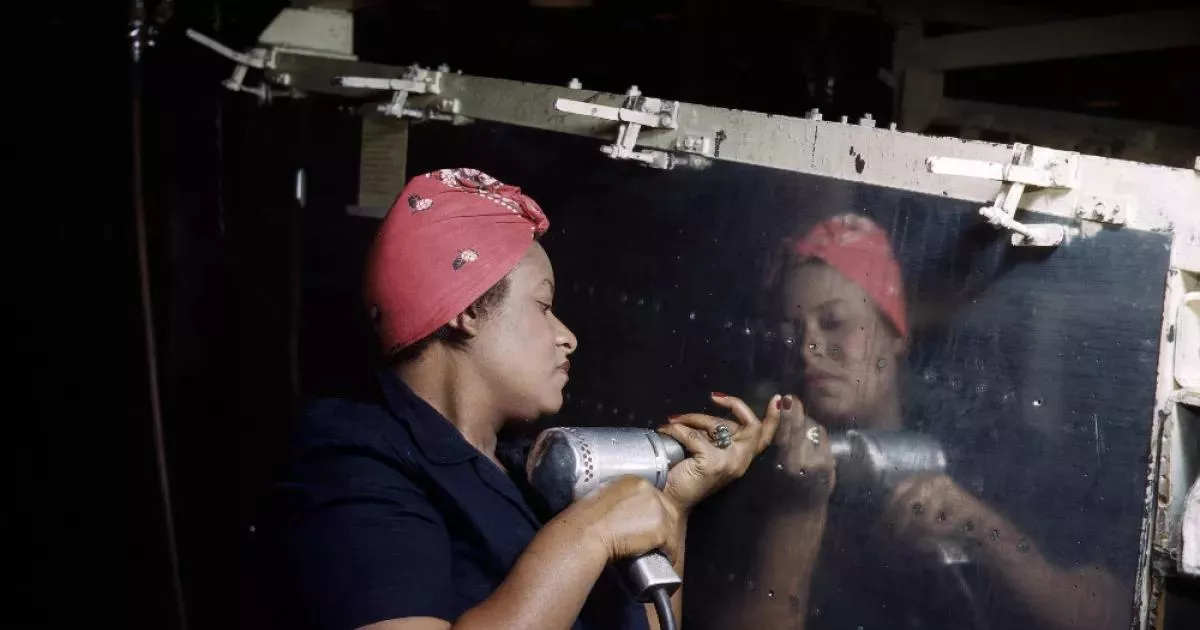Rosie the Riveter is an iconic symbol of American women's contribution to the war effort during World War II. Representing women working in factories and shipyards, often replacing men in the military, Rosie promoted female empowerment and economic independence. Popularized by the "We Can Do It!" poster, her image emerged from a 1942 song and was widely used in government campaigns and media to encourage women's wartime participation in traditionally male-dominated industries.
1940: The Pre-War Workforce Landscape
Before the significant impact of "Rosie the Riveter," the number of working women in the US was notably lower in 1940.
1941: Ronnie, the Bren Gun Girl: Canada's Wartime Icon
In 1941, Veronica Foster became "Ronnie, the Bren Gun Girl," symbolizing Canadian women's contributions to the war effort, similar to the American Rosie the Riveter.
1942: Expanding Opportunities and Breaking Barriers
In 1942, the need for women workers, including African American women, increased dramatically, leading to a breakdown of social barriers and increased diversity in the workforce.
1942: Mary Doyle poses for Rockwell's "Rosie the Riveter"
In late 1942, Mary Doyle, who would later become the inspiration for Rockwell's "Rosie the Riveter," participated in two photography sessions with Rockwell's photographer, Gene Pelham. These photographs would serve as references for the iconic painting.
1942: The Creation of "We Can Do It!"
J. Howard Miller designed the iconic "We Can Do It!" poster in 1942 for Westinghouse, though it wasn't originally associated with "Rosie the Riveter."
1942: The Origin of Rosie the Riveter
The idea of Rosie the Riveter emerged in 1942 with a song by Redd Evans and John Jacob Loeb, becoming a symbol of women in the workforce during World War II.
1942: "Rosie the Riveter": A Musical Tribute
The song "Rosie the Riveter" was recorded by various artists in 1942, including Kay Kyser and The Four Vagabonds, turning Rosie into a national symbol of female empowerment.
February 1943: The Short-Lived Display and Later Rise of "We Can Do It!"
Despite its later fame, the "We Can Do It!" poster was only briefly displayed in February 1943. It wasn't until the 1980s that it was rediscovered, becoming a symbol of female empowerment.
May 29, 1943: Norman Rockwell's "Rosie the Riveter" published in The Saturday Evening Post
On May 29, 1943, Norman Rockwell's iconic "Rosie the Riveter" image was featured on the cover of The Saturday Evening Post. This powerful illustration, depicting a strong woman on her lunch break with a rivet gun and a copy of "Mein Kampf" under her foot, quickly resonated with the public.
1944: Shifting Societal Expectations
As World War II neared its end in 1944, government propaganda shifted, encouraging women to return to domestic life, despite their contributions to the war effort.
1944: Rosie's Impact on the Workforce
By 1944, inspired by "Rosie the Riveter," the number of working women in the US rose dramatically, highlighting the icon's influence on women's roles in the workforce.
1944: Rosie the Riveter in Hollywood
In 1944, a Hollywood film titled "Rosie the Riveter" was released, starring Jane Frazee, further solidifying the icon's place in American culture.
1944: Rosie on the Silver Screen
The 1944 film "Rosie the Riveter," starring Jane Frazee, borrowed from the iconic Rosie theme, showcasing the impact of the figure on popular culture.
1947: The Decline of Women in the Workforce
By 1947, the percentage of women working dropped significantly, reflecting the societal pressure for women to return to traditional roles after the war.
1949: Mary Doyle marries Robert J. Keefe
Mary Doyle, the model for Rockwell's "Rosie the Riveter," married Robert J. Keefe in 1949, becoming Mary Doyle Keefe.
1980: "The Life and Times of Rosie the Riveter": A Documentary
The 1980 documentary "The Life and Times of Rosie the Riveter" chronicles the experiences of women in male-dominated industries during World War II.
May 1984: Rosie the Riveter: From Posters to Pop Culture
Rosie the Riveter's image transcended from wartime propaganda to mainstream pop culture, appearing in video games, comics, and other media starting as early as May 1984.
1999: "Rosies of the North": A Canadian Perspective
The 1999 documentary "Rosies of the North" highlights the contributions of Canadian women who worked in factories during World War II, similar to the American Rosies.
October 14, 2000: Honoring Rosie: A National Historical Park
The Rosie the Riveter/World War II Home Front National Historical Park opened on October 14, 2000, in Richmond, California, commemorating the contributions of women during World War II.
2002: The Keefes attend the Sotheby's auction of "Rosie the Riveter"
In 2002, Mary Doyle Keefe and her husband, Robert J. Keefe, were present at the Sotheby's auction where Rockwell's "Rosie the Riveter" was sold, witnessing the painting's impact and appreciation firsthand.
2002: Rockwell's "Rosie the Riveter" auctioned for nearly $5 million
In 2002, the original "Rosie the Riveter" painting by Norman Rockwell was sold for almost $5 million at a Sotheby's auction, demonstrating the significant value and recognition of the artwork.
June 2009: Rockwell's "Rosie the Riveter" acquired by Crystal Bridges Museum
In June 2009, the Crystal Bridges Museum of American Art in Bentonville, Arkansas, obtained Norman Rockwell's renowned painting, "Rosie the Riveter", adding the culturally significant piece to their permanent collection.
2009: "Four Freedoms": A Novel's Nod to Rosie
John Crowley's 2009 novel "Four Freedoms" references "Rosie the Riveter," illustrating the lasting impact of the icon on historical fiction and narratives about the home front during World War II.
2010: Pink's Musical Tribute to Rosie
Singer Pink honored Rosie the Riveter in 2010 by dressing as the icon in her music video for "Raise Your Glass," showcasing the icon's enduring legacy.
2013: Rosie Revere, Engineer: Inspiring Future Generations
The 2013 children's book "Rosie Revere, Engineer" features a character inspired by Rosie the Riveter, highlighting her enduring legacy and inspiring young girls to pursue STEM careers.
July 2014: Beyoncé's Rosie Tribute and the Ensuing Discussion
Beyoncé's tribute to Rosie the Riveter in July 2014, while popular, sparked debate, highlighting the complexities of using historical icons in contemporary contexts.
2014: Bridging Generations: Honoring Rosies and Educating Youth
In 2014, a nationwide program was launched to connect "Rosies" with younger generations, sharing their experiences and educating youth about women's roles in World War II.
2014: Mary Doyle Keefe reflects on the impact of "Rosie the Riveter"
In a 2014 interview, Mary Doyle Keefe shared her surprise at the enduring impact of the "Rosie the Riveter" painting. She admitted that she hadn't anticipated its significance at the time but grew to understand its cultural weight over the years.
2014: Phyllis Gould: Advocating for Rosie's Recognition
Phyllis Gould, an original Rosie the Riveter, began advocating for national recognition of Rosies in 2014, leading to significant strides in honoring these women.
April 21, 2015: Mary Doyle Keefe passes away
Mary Doyle Keefe, the inspiration behind Rockwell's iconic "Rosie the Riveter" painting, died on April 21, 2015, in Connecticut. She was 92 years old.
2017: A Day for Rosie: Senate Approves National Observance
In 2017, the US Senate approved a National Rosie the Riveter Day, a testament to the advocacy of individuals like Phyllis Gould and the growing recognition of Rosies' contributions.
2022: Gold Medal for Rosies: A Lasting Tribute
Starting in 2022, a Gold Medal will be awarded to Rosies, a culmination of years of advocacy and a symbol of the nation's gratitude for their service during World War II.
Mentioned in this timeline
California is a U S state on the Pacific Coast...
Connecticut is a state in the New England region of...
Canada is a North American country the second largest in...

Music is a cultural universal involving the arrangement of sound...

Books are a means of storing information as text or...

War is defined as an armed conflict involving the organized...
Trending
1 month ago Christian Gonzalez shines for Patriots, recovers from concussion, ready for Week 10.

Kyle Van Noy is an American football linebacker currently playing for the Baltimore Ravens He played college football at BYU...
TreVeyon Henderson is an American professional football running back for the New England Patriots of the NFL He played college...

3 months ago Mike Vrabel on Patriots' Defense and Primetime Matchup Against Bills

3 months ago Cardi B and Nicki Minaj Feud Reignites With Scathing Messages and Online Sparring.
Marlon Humphrey is a professional football cornerback for the Baltimore Ravens in the NFL He played high school football at...
Popular

Candace Owens is an American conservative political commentator and author...

Tucker Carlson is an American conservative political commentator known for...

XXXTentacion born Jahseh Dwayne Ricardo Onfroy was a controversial yet...

Ben Shapiro is a prominent American conservative political commentator media...

William Franklin Graham III commonly known as Franklin Graham is...

Bill Gates an American businessman and philanthropist revolutionized personal computing...
